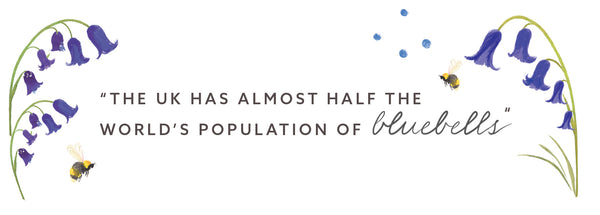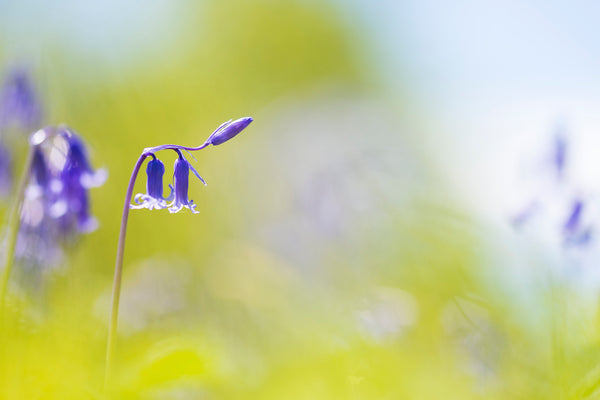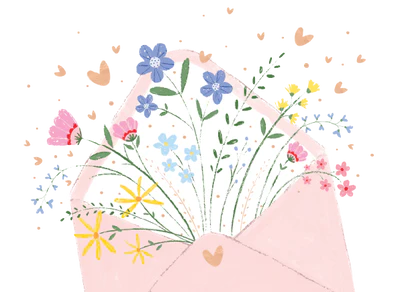Top 10 places to see beautiful Bluebells in Cornwall
The bluebell is one of our most famous and unmistakable woodland flowers. Each year we await these unique florals that create a blue blanket across the ground layer of woodland, awakening the damp and dull vegetation for the upcoming summer. Like many areas in the UK, Cornwall is abundant with bluebells, but you must hurry to see them because they don't last long! The best time to see bluebells is between Mid/ Late April and May, and we have to admit that, Cornwall is truly spoilt for great locations to go and see them in their masses.
Top 10 places to see bluebells in Cornwall:
- Enys Gardens
- Tehidy Woods
- Lanhydrock
- Cardinham Woods
- Godolphin Estate
- Cabilla and Redrice Woods
- Pendarves Woods
- The Lost Gardens of Heligan
- Pencarrow House and Gardens
- Trebah Garden
Pictured Bluebells Gift bag Small (£2.95) >

A word from Cornwall Wildlife Trust
One of the most wonderful moments in spring each year is the first sight of a carpet of bluebells in a woodland. Anne Brontë conveys something of the feeling in the opening of her poem, ‘The Bluebell’:
There is a silent eloquence
In every wild bluebell
That fills my softened heart with bliss
That words could never tell.
‘Silent eloquence’ captures well what these wonderful flowers offer us. Somehow they tell us that everything is going to be alright: spring has come and the universe is capable of this extraordinary colour as a feast for our eyes. Little surprise it has been given the title of ‘Nation’s favourite flower’!
Bluebells are usually a deep violet-blue in colour. And, as millions of bulbs may exist in one woodland, the carpet effect is a wonderful feature of spring. (April to May is the best time to see them.) But take a closer look: they’re just as impressive individually. They are shaped like bells, with six petals, each with a turned-up tip, which explains why they’ve sometimes been called ‘lady’s nightcap’.

They’re also a particularly special feature of the United Kingdom. We have almost half the world’s population, while they’re relatively rare elsewhere. They can be seen in woodlands, and are often taken as an indicator (along with other species) as a clue to whether a wood is ancient. You can also see them growing in hedgerows and fields.

Photo: Bluebell Macro by Ben Watkins
But take care with identification. Native bluebells could easily be confused with Spanish bluebells, which were introduced to Britain around the late 17th century. Unfortunately, this species has escaped from our gardens and have begun to mix with our native species, putting them under threat. Fortunately, it’s fairly easy to tell the difference. Spanish bluebells grow upright and their flowers are all round the stem, rather than drooping to one side. The hybrid bluebell is, unfortunately, harder to tell apart – and could pose a threat to our native bluebell.
So, where are some of the best places to see bluebells? We’re fortunate in Cornwall to have a number of nature reserves where you can enjoy seeing them. One of the best places in East Cornwall to enjoy bluebells is Cabilla and Redrice Woods, one of Cornwall’s finest ancient woodlands. Further down in West Cornwall, you will find Pendarves Wood, a broadleaved woodland near Camborne which has streams and a lake.

Photo: 'Path Through Bluebells' at Pendarves Wood Nature Reserve
by Ben Watkins
Bluebells are really valuable to wildlife in the UK. Many pollinating insects are attracted by them as they flower earlier than other plants. This makes it all the more important that we take care of our bluebells. They can be damaged by trampling and take years to recover as it takes them so long to grow.
Fortunately, bluebells are protected under the Wildlife and Countryside Act (1981). Digging up the plant or bulb in the countryside is prohibited, so please enjoy them where you see them, but leave them there. Like other Wildlife Trusts, Cornwall Wildlife Trust’s staff and volunteers are working hard to manage many woodland nature reserves sympathetically for the benefit of all kinds of wildlife. A mix of coppicing, scrub-cutting, ride maintenance and non-intervention all help woodland wildlife to thrive.

How can you help to support nature in Cornwall?
You can help support Cornwall Wildlife Trust this May. During April and May 2023 Whistlefish is donating funds to Cornwall Wildlife Trust for every greeting card sold across stores and online at whistlefish.com
This is part of the Whistlefish '1 Good Cause' campaign - supporting a different charity each month by fundraising via card sales.
Read more about Whistlefish Charity Support One Good Cause >
How else can you support Cornwall Wildlife Trust?
You can help support the work of Cornwall Wildlife Trust by becoming a member. You can sign up easily on their website for just £2.50 a month! Other tiers of membership include Joint and Family memberships. Depending on the membership you have you will receive free goodies each month.
If people would like to become a member and support the work of Cornwall Wildlife Trust visit their website to find out more and join: https://www.cornwallwildlifetrust.org.uk/support-us/become-member



